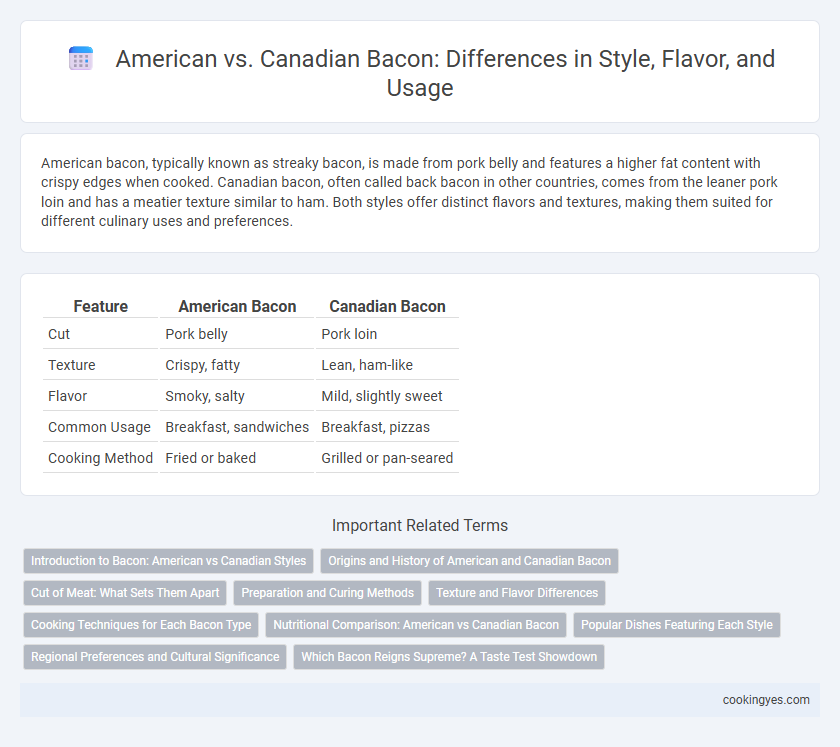American bacon, typically known as streaky bacon, is made from pork belly and features a higher fat content with crispy edges when cooked. Canadian bacon, often called back bacon in other countries, comes from the leaner pork loin and has a meatier texture similar to ham. Both styles offer distinct flavors and textures, making them suited for different culinary uses and preferences.
Table of Comparison
| Feature | American Bacon | Canadian Bacon |
|---|---|---|
| Cut | Pork belly | Pork loin |
| Texture | Crispy, fatty | Lean, ham-like |
| Flavor | Smoky, salty | Mild, slightly sweet |
| Common Usage | Breakfast, sandwiches | Breakfast, pizzas |
| Cooking Method | Fried or baked | Grilled or pan-seared |
Introduction to Bacon: American vs Canadian Styles
American bacon, commonly known as streaky bacon, is made from pork belly and features alternating layers of meat and fat, resulting in a crispy texture when cooked. Canadian bacon, or back bacon, is leaner and cut from the pork loin, resembling ham with a tender, meaty consistency and often smoked. Both styles offer distinct flavors and textures, reflecting regional preferences and culinary traditions in North America.
Origins and History of American and Canadian Bacon
American bacon, also known as streaky bacon, originates from pork belly and has roots in early American colonial curing traditions, emphasizing smoky, salty flavors developed through extensive smoking and curing processes. Canadian bacon, derived from pork loin, has a distinct history tied to Canadian preservation methods and British back bacon influences, characterized by a leaner, rounder cut that is cured and often fully cooked or smoked. Both styles reflect regional meat processing traditions that shaped their unique textures and flavors, with American bacon favored for its crispy fattiness and Canadian bacon prized for its ham-like quality.
Cut of Meat: What Sets Them Apart
American bacon primarily comes from pork belly, offering a streaky, fatty texture and rich flavor, while Canadian bacon is cut from the leaner pork loin, resulting in a meatier, ham-like texture. The difference in cut significantly influences cooking methods and taste profiles, with American bacon crisping up due to its fat content, whereas Canadian bacon tends to be firmer and less greasy. This fundamental variation defines the distinctive culinary roles of each bacon style in American and Canadian cuisine.
Preparation and Curing Methods
American bacon, also called streaky bacon, is typically made from pork belly and cured using a combination of salt, sugar, and smoking, resulting in a crispy texture and smoky flavor when cooked. Canadian bacon, known as back bacon, is made from pork loin, cured with a wet brine solution, and often fully cooked or smoked, giving it a leaner, ham-like texture. The preparation differences reflect regional preferences: American bacon is fried until crisp, while Canadian bacon is sliced and heated to maintain its tender, meatier consistency.
Texture and Flavor Differences
American bacon typically features a streaky texture with a higher fat content, resulting in a crispy and salty flavor profile when cooked. Canadian bacon, cut from the pork loin, offers a leaner, meatier texture with a milder, slightly sweet taste closer to ham. The textural contrast lies in American bacon's chewy fattiness versus Canadian bacon's tender, ham-like consistency.
Cooking Techniques for Each Bacon Type
American bacon is typically made from pork belly and is cooked by frying or baking until crispy, emphasizing a balance of fat and lean meat for a rich, smoky flavor. Canadian bacon, derived from pork loin, requires grilling or pan-searing to achieve a tender texture with less fat and a slightly sweet, ham-like taste. Cooking techniques for American bacon favor longer exposure to heat to render fat and crisp slices, while Canadian bacon benefits from quick, high-heat methods to preserve moisture and enhance its lean profile.
Nutritional Comparison: American vs Canadian Bacon
American bacon, typically made from pork belly, contains higher fat content and calories compared to Canadian bacon, which is leaner and derived from pork loin. Canadian bacon offers more protein per serving and usually has lower sodium levels, making it a healthier choice for those monitoring their nutrient intake. Nutritional differences impact diet plans, with American bacon suited for flavor-rich meals while Canadian bacon supports lower-fat and lower-calorie diets.
Popular Dishes Featuring Each Style
American bacon, typically made from pork belly and known for its crispy texture, is a staple in dishes like BLT sandwiches, bacon cheeseburgers, and breakfast plates featuring scrambled eggs or pancakes. Canadian bacon, derived from lean pork loin and boasting a ham-like flavor, prominently appears in eggs Benedict, breakfast sandwiches, and pizza toppings. Both styles showcase distinct culinary uses that highlight their unique textures and flavors in popular North American dishes.
Regional Preferences and Cultural Significance
American bacon typically features streaky pork belly slices known for their crispy texture and smoky flavor, favored in the southern and eastern United States. Canadian bacon, derived from leaner pork loin, offers a ham-like taste and is extensively enjoyed in Canada and northeastern U.S. regions. These regional preferences highlight cultural distinctions, with American bacon often used in hearty breakfasts and sandwiches while Canadian bacon is a staple in brunch dishes like Eggs Benedict.
Which Bacon Reigns Supreme? A Taste Test Showdown
American bacon, typically made from pork belly, has a streaky, fatty texture and a smoky, salty flavor profile favored in the United States. Canadian bacon, derived from lean pork loin, offers a tender, ham-like consistency with a milder, slightly sweet taste preferred in Canada. Taste test showdowns reveal that American bacon excels in crispiness and robust flavor, while Canadian bacon appeals with its leaner cut and subtle sweetness, making preference largely dependent on individual palate and culinary use.
American vs Canadian for Bacon Style Infographic

 cookingyes.com
cookingyes.com